
Marlink has added new satellites and beams to their global Sealink VSAT network to provide broader flexible access to reliable, high-speed Internet connectivity, enabling operational, crew and guest communications in the fast-growing adventure cruising and bandwidth-hungry superyacht markets.
Adding new capacity is part of Marlink’s strategy to offer a multi-layered network of high-power overlapping beams, delivering redundancy in congested or remote areas to ensure access to high-quality voice and data services.

The new coverage in the Northwest Passage, the Mediterranean and Caribbean delivers even more potential for digital transformation in the adventure cruise and superyacht sectors. With even more satellites and beams added, Marlink offers one of the largest VSAT networks dedicated to maritime users, offering both beam and frequency redundancy.
A new satellite has been added to the Marlink VSAT network to augment Ku-band coverage in the Northwest Passage, from the east coast of Canada to the western tip of Alaska, helping to open the region further for cruise ships and superyachts looking for adventure off the beaten track.
Executive Comment
Marlink has also added new widebeam HTS coverage to overlap existing capacity in more traditional cruise and yachting regions, illuminating the entire Mediterranean Sea. More capacity has also been added for seasonal peak demands, and additional coverage has been added in the most popular Caribbean yachting destinations. Cruise ships, yachts and commercial vessels crossing the Atlantic are now also supported by extra capacity to stay connected at sea at any time.
Tore Morten Olsen, the President of Maritime at Marlink said that as demand for bandwidth increases in all maritime verticals, the company's combination of satellites, beams and overall orbital spread enables us to maximize the availability, speed, flexibility and agility of the connectivity services the firm provides, while ensuring high throughput even thousands of miles from the equator. With sea ice receding due to climate change, larger vessels are now able to further explore the Northwest Passage, which is generating significant extra demand for connectivity. Choosing a provider with more sources of high throughput services enabled by redundant and overlapping satellite coverage ensures quality of service, resulting in more uptime even in the most remote regions.

